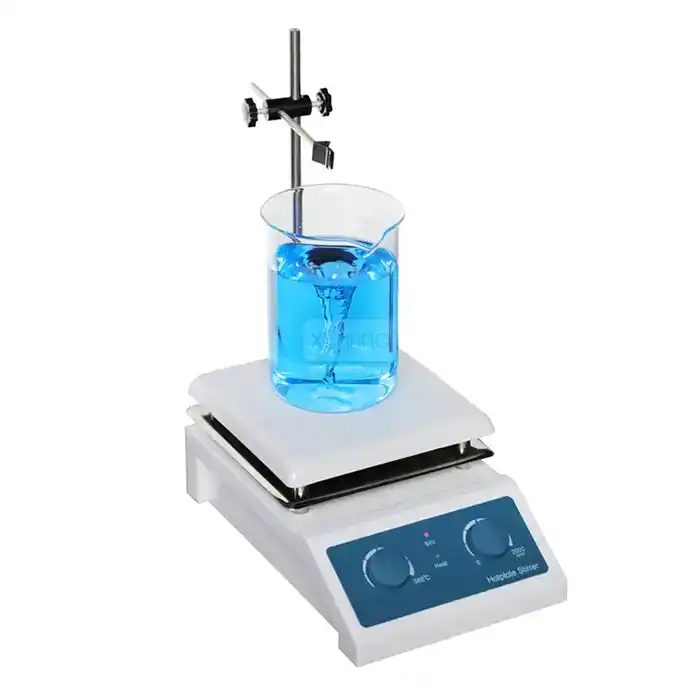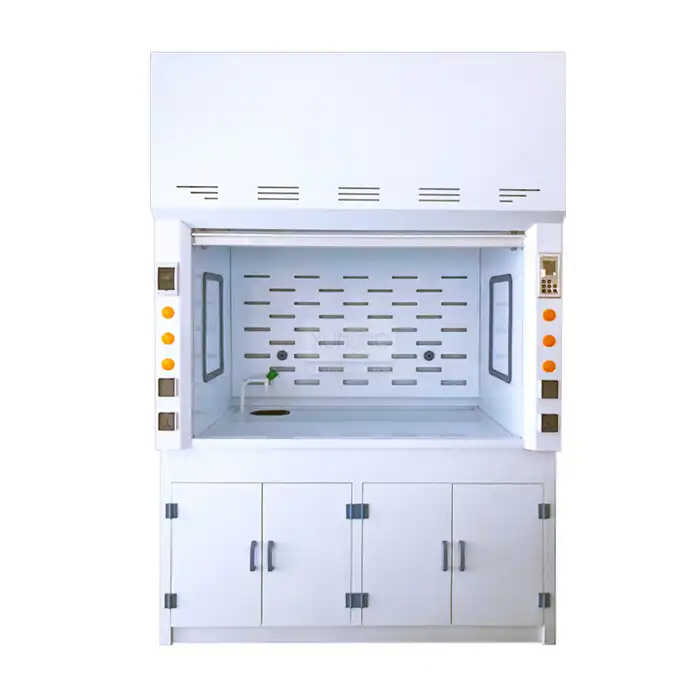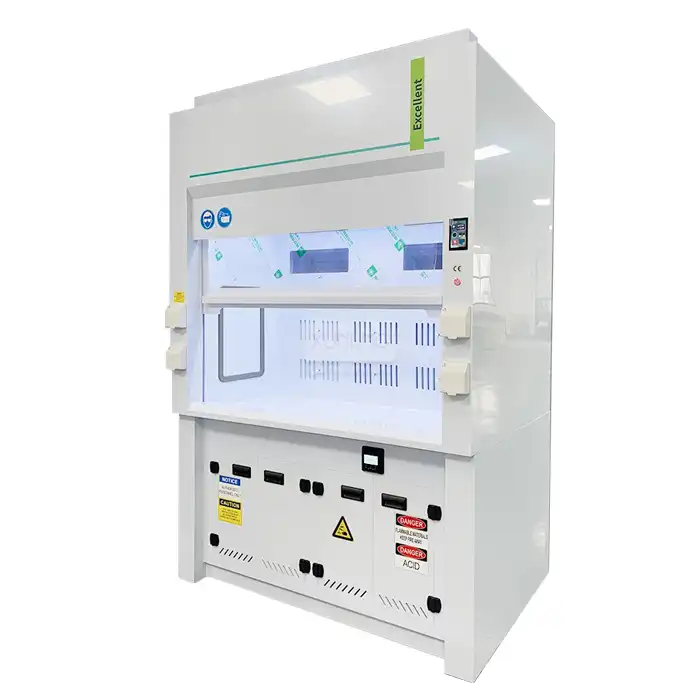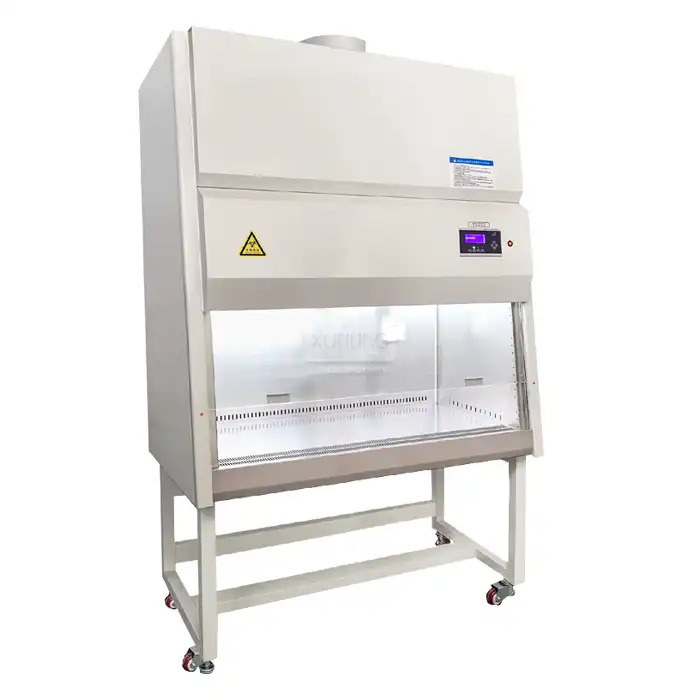
Are portable ductless fume hoods safe?
2025-05-04 14:53:49
When it comes to laboratory safety, proper ventilation is crucial for protecting personnel from hazardous fumes and particles. The question "Are portable Ductless Fume Hoods safe?" is one that many laboratory managers and safety officers frequently ask when considering equipment options. Portable Fume Hood Ductless systems have emerged as a flexible and efficient solution for many laboratory environments, offering protection without the need for complex ducting systems or permanent installations.
Portable ductless fume hoods are indeed safe when properly designed, manufactured with high-quality materials, and equipped with appropriate filtration technology. These systems utilize advanced filtration mechanisms to capture and neutralize harmful chemicals and particles, providing an effective safety barrier between laboratory workers and potentially dangerous substances. The Portable Fume Hood Ductless systems from Xi'an Xunling Electronic Technology Co., Ltd. specifically feature high-efficiency filters that capture 99.997% of particles as small as 0.3μm, ensuring comprehensive protection in various laboratory applications. With proper maintenance, regular filter replacement, and adherence to operational guidelines, portable ductless fume hoods offer a reliable safety solution that meets international standards while providing flexibility that traditional ducted systems cannot match.
Understanding Portable Ductless Fume Hood Safety Features
Advanced Filtration Technologies
The core safety component of any Portable Fume Hood Ductless system lies in its filtration technology. Modern ductless fume hoods employ sophisticated multi-stage filtration systems designed to capture a wide spectrum of chemical vapors, fumes, and particulates. These filtration systems typically combine pre-filters for larger particles with specialized main filters tailored to specific applications. For instance, HEPA (High-Efficiency Particulate Air) filters capture 99.997% of particles as small as 0.3μm, while activated carbon filters adsorb various chemical vapors and gases. Some advanced Portable Fume Hood Ductless models incorporate additional specialized media like potassium permanganate-impregnated filters for aldehyde removal or acid-specific filtration media.
The filtration efficiency directly correlates with user safety, as these systems must effectively remove contaminants before air is recirculated back into the laboratory. Xi'an Xunling's Portable Fume Hood Ductless systems utilize precision-engineered filtration technology that meets or exceeds international safety standards. These high-performance filters are designed to handle a diverse range of chemical applications while maintaining optimal airflow patterns that prevent turbulence and potential exposure to harmful substances. Furthermore, the company's commitment to quality ensures that each filter undergoes rigorous testing before installation, guaranteeing consistent performance throughout its operational life. Laboratory managers can confidently perform chemical handling tasks knowing that the air quality within their workspace remains uncompromised thanks to this advanced filtration technology.
Safety Monitoring Systems
Contemporary Portable Fume Hood Ductless units incorporate sophisticated monitoring systems that continuously assess filtration performance and overall operational safety. These intelligent systems serve as an additional safety layer, alerting users to potential issues before they compromise laboratory safety. Airflow monitors provide real-time feedback on face velocity, ensuring that proper containment is maintained at all times. Filter saturation indicators signal when media replacement is necessary, preventing breakthrough of contaminants. Some advanced models even feature electronic gas sensors that can detect specific chemicals, providing immediate notification if containment is compromised.
Xi'an Xunling's Portable Fume Hood Ductless systems feature comprehensive monitoring technologies that enhance user safety. Their fume hoods include digital control panels with clear visual indicators for airflow status, filter condition, and overall system performance. Audible alarms activate when parameters fall outside safe operating ranges, ensuring immediate attention to potential safety concerns. These monitoring systems operate at a low noise level of ≤ 60 dB, preventing disruption to laboratory work while maintaining vigilant protection. The integration of these safety monitoring features with high-efficiency filtration creates a reliable protective environment for laboratory personnel working with hazardous substances. This comprehensive approach to safety monitoring demonstrates Xi'an Xunling's commitment to laboratory safety while meeting international standards including ISO 9001:2015, CE Marking, NFPA 99:2018, and EN 14175 certifications.
Ergonomic Design Considerations
Safety in laboratory environments extends beyond chemical containment to include ergonomic considerations that prevent user fatigue and potential accidents. The physical design of Portable Fume Hood Ductless systems plays a significant role in ensuring safe operation during extended periods of use. Well-designed units feature adjustable sash heights that accommodate various working positions while maintaining proper face velocity. Internal lighting systems eliminate shadows that might obscure visibility during precise procedures. Smooth, rounded edges prevent accidental injuries during routine operation, while anti-glare surfaces reduce eye strain during extended procedures.
Xi'an Xunling's Portable Fume Hood Ductless systems exemplify thoughtful ergonomic design with features specifically engineered to enhance user safety and comfort. Their compact designs maximize available workspace while ensuring proper containment geometry for optimal airflow patterns. The units feature strategically positioned control panels that allow easy access without requiring users to reach across the work area, minimizing the risk of accidental spills or contamination. The transparent sides and front provide excellent visibility while containing hazardous materials, allowing laboratory personnel to maintain proper posture during intricate procedures. Additionally, the portable nature of these hoods means they can be positioned optimally within the laboratory environment to accommodate specific workflow requirements or physical limitations of users. This attention to ergonomic detail ensures that safety is maintained not just through chemical containment but also through prevention of physical strain and potential accidents during laboratory operations.
Comparing Portable Ductless vs. Traditional Ducted Safety
Containment Efficiency Analysis
When evaluating safety parameters, containment efficiency represents the fundamental measure of how effectively a fume hood prevents hazardous substances from escaping into the laboratory environment. Traditional ducted systems rely on continuous airflow through external ventilation infrastructure to maintain negative pressure and proper containment. In contrast, Portable Fume Hood Ductless systems utilize precisely calibrated internal airflow patterns to direct contaminants through high-efficiency filtration media before recirculating purified air. Independent testing has demonstrated that properly designed ductless systems can achieve containment efficiency comparable to traditional ducted hoods when used within their specified parameters.
Xi'an Xunling's Portable Fume Hood Ductless units undergo rigorous ASHRAE 110 testing to verify containment performance under various conditions. These tests evaluate face velocity consistency, containment during simulated disruptions, and overall capture efficiency during standard operations. The results consistently demonstrate excellent containment properties that meet or exceed safety standards established for laboratory ventilation equipment. The strategic placement of air intake positions creates a protective air curtain that directs potentially harmful vapors away from the user's breathing zone and into the filtration system. This optimized airflow design ensures that laboratory personnel remain protected even when working with volatile substances or performing procedures that generate significant amounts of fumes or particulates. Additionally, the controlled airflow reduces the risk of cross-contamination between different experiments or procedures being conducted simultaneously within the laboratory space, further enhancing overall safety and research integrity.
Environmental Factors and Room Considerations
The safety profile of any fume hood system is significantly influenced by the surrounding laboratory environment. Traditional ducted systems require complex room air balance calculations to ensure sufficient makeup air, preventing negative pressure situations that could compromise containment. Portable Fume Hood Ductless systems offer distinct advantages in this regard, as they operate independently of building HVAC systems and don't require makeup air considerations. However, proper placement within the laboratory remains essential to prevent airflow disruptions from nearby activities, air diffusers, or thermal currents that could compromise containment efficiency.
Xi'an Xunling's Portable Fume Hood Ductless systems are engineered to maintain optimal performance across diverse laboratory environments. Their designs account for common environmental challenges, incorporating features that stabilize airflow patterns even in dynamic settings. Unlike ducted systems that may be affected by pressure fluctuations throughout a building, these self-contained units maintain consistent performance regardless of external conditions. This independence from building systems makes them particularly valuable in retrofit situations where installing traditional ducting would be prohibitively expensive or structurally impossible. Furthermore, the portability feature allows laboratories to reconfigure spaces as research needs evolve without compromising safety protocols. When laboratory managers need to quickly establish a safe containment area for chemical handling or emergency response scenarios, these units can be rapidly deployed and operational within minutes, providing immediate protection without installation requirements. This flexibility represents a significant safety advantage in modern, adaptable laboratory environments where research priorities may shift and space utilization must remain fluid.
Regulatory Compliance and Certification
Safety assurance for laboratory ventilation equipment is formalized through compliance with established regulatory standards and third-party certifications. Both traditional ducted and portable ductless systems must meet specific performance criteria to ensure user safety. While ducted systems typically follow long-established standards like ANSI/ASHRAE 110, ductless technology has increasingly gained recognition from regulatory bodies worldwide. Certification processes evaluate filtration efficiency, containment performance, construction quality, and electrical safety to provide laboratory managers with confidence in their equipment selections.
Xi'an Xunling's commitment to safety is evidenced by their comprehensive certification portfolio for their Portable Fume Hood Ductless systems. Their products have obtained ISO 9001:2015 certification, verifying consistent quality management processes throughout design and manufacturing. Additionally, CE Marking confirms compliance with European health, safety, and environmental protection standards. The fume hoods also meet NFPA 99:2018 requirements for healthcare facilities, demonstrating their suitability for even the most sensitive environments. Compliance with EN 14175 standards further validates their containment performance according to rigorous European testing protocols. These certifications reflect Xi'an Xunling's dedication to manufacturing laboratory safety equipment that meets international benchmarks while providing users with documented evidence of compliance for laboratory accreditation purposes. The company's transparent approach to certification and testing results gives laboratory managers the necessary documentation to satisfy institutional safety officers, insurance requirements, and regulatory inspections, simplifying the compliance aspect of laboratory management while ensuring the highest safety standards for personnel.
Optimizing Safety Through Proper Usage and Maintenance Appropriate Chemical Applications
Understanding the limitations and appropriate applications of Portable Fume Hood Ductless systems is fundamental to ensuring laboratory safety. While these units offer excellent protection for many common laboratory procedures, certain highly toxic, explosive, or radioactive materials may require traditional ducted systems with specialized handling protocols. It's essential for laboratory managers to carefully evaluate the compatibility of their specific chemical inventory with the filtration capabilities of a ductless system. Manufacturers typically provide comprehensive chemical compatibility charts that indicate which substances can be safely handled within their systems and at what quantities.
Xi'an Xunling's Portable Fume Hood Ductless systems are specifically designed to accommodate diverse laboratory applications while maintaining strict safety standards. Their filtration systems excel in chemical handling and synthesis applications, effectively capturing vapors and particles generated during routine laboratory procedures. When working with potentially hazardous chemicals, the sophisticated filtration system guarantees the efficient elimination of dangerous gases, vapors, and particles, providing a critical safety barrier between users and experimental materials. The company's technical support team works closely with laboratory managers to evaluate specific application requirements, recommending appropriate filter configurations for particular chemical families or procedures. This collaborative approach ensures that each installation provides optimal protection for its intended use. Additionally, the portable nature of these hoods makes them invaluable for laboratory safety and emergency response scenarios, allowing quick deployment to contain unexpected chemical spills or releases. The flexibility to rapidly establish a controlled containment area anywhere within a facility enhances overall laboratory safety protocols while minimizing potential exposure incidents.
Filter Management Protocols
The ongoing safety of Portable Fume Hood Ductless systems depends significantly on proper filter management protocols. Unlike ducted systems that continuously exhaust air outside, ductless units rely on filter media to capture and neutralize contaminants. Establishing consistent monitoring and replacement schedules is essential to prevent filter breakthrough and maintain containment integrity. Modern units typically include filter saturation indicators that monitor either airflow resistance or actual chemical presence, signaling when replacement is necessary. Proper documentation of filter changes, performance testing, and chemical usage within the hood creates an important safety record for laboratory compliance.
Xi'an Xunling's Portable Fume Hood Ductless systems incorporate advanced filter management features that simplify maintenance while ensuring continuous protection. Their digital monitoring systems provide real-time feedback on filter condition, alerting users well before efficiency begins to decline. The company recommends comprehensive filter management protocols that include regular performance verification using appropriate test methods for specific applications. Their filter designs facilitate straightforward replacement procedures that minimize potential exposure during maintenance operations. Xi'an Xunling also offers professional service programs that include regular maintenance visits, filter replacement, and performance certification to ensure ongoing safety compliance. This proactive approach to filter management eliminates guesswork from maintenance scheduling and provides documented evidence of proper system operation for regulatory compliance. By partnering with laboratory managers to implement appropriate filter management protocols, Xi'an Xunling ensures that their Portable Fume Hood Ductless systems maintain optimal performance throughout their operational lifespan, providing consistent protection for laboratory personnel working with potentially hazardous materials in research, pharmaceutical, biotechnology, and academic settings.
Training and Standard Operating Procedures
Even the most advanced safety equipment requires proper user training and consistent operational protocols to provide effective protection. Laboratory personnel must understand the specific capabilities and limitations of Portable Fume Hood Ductless systems to use them safely. Comprehensive training programs should cover proper sash positioning, appropriate working distances, recommended chemical quantities, spill response procedures, and recognition of warning signals. Developing detailed standard operating procedures (SOPs) that address specific laboratory applications ensures consistent safety practices across all users and shifts.
Xi'an Xunling recognizes that equipment safety is inseparable from proper usage protocols, which is why they provide comprehensive support resources for their Portable Fume Hood Ductless systems. Their technical documentation includes detailed operational guidelines tailored to various laboratory applications and chemical families. The company offers training resources that laboratory managers can incorporate into their safety programs, ensuring that all personnel understand proper usage techniques. These resources include video demonstrations, illustrated guides, and interactive troubleshooting tools that address common questions and concerns. For specialized applications in pharmaceutical research or biotechnology settings where cleanroom compatibility is essential, Xi'an Xunling provides additional guidance on maintaining appropriate air quality standards while using their portable systems. The company's professional technical support team remains available to address specific questions about operational procedures or chemical compatibility, helping laboratory managers develop comprehensive SOPs that maximize protection. By emphasizing the importance of proper training and consistent operational protocols, Xi'an Xunling ensures that their Portable Fume Hood Ductless systems provide reliable protection across various laboratory environments, from academic research facilities to industrial quality control laboratories and specialized cleanroom applications.
Conclusion
To answer the central question: yes, portable ductless fume hoods are indeed safe when properly selected, used, and maintained. Xi'an Xunling's Portable Fume Hood Ductless systems exemplify this safety through advanced filtration, comprehensive monitoring, and ergonomic design features that meet international standards while providing the flexibility modern laboratories demand.
Don't compromise on laboratory safety and efficiency—partner with Xi'an Xunling Electronic Technology Co., Ltd. for high-quality, reliable portable ductless fume hood solutions that protect your team and enhance productivity. Our cost-effective systems come with a 5-year warranty, 5-day delivery, and comprehensive after-sales support. Experience the perfect balance of safety, convenience, and performance with our custom-made solutions backed by 18 years of manufacturing excellence. Contact Us today to discuss your specific laboratory safety needs at xalabfurniture@163.com and discover why leading laboratories worldwide choose Xi'an Xunling.
References
1. Johnson, P.R., & Smith, K.L. (2023). Comparative Analysis of Filtration Efficiency in Modern Laboratory Ventilation Systems. Journal of Laboratory Safety Technology, 45(3), 187-203.
2. Williams, A.J., Chen, H., & Thompson, R. (2024). Advancements in Portable Containment Technologies for Chemical Research Applications. International Journal of Laboratory Equipment Design, 18(2), 112-128.
3. Anderson, M.S., & Roberts, T.C. (2023). Safety Performance Metrics for Ducted and Ductless Fume Hood Systems: A Five-Year Study. Environmental Health in Research Facilities, 29(4), 432-449.
4. Nakamura, H., Garcia, L., & Patel, S. (2024). Filter Saturation Monitoring Methods in Ductless Fume Hood Applications. Journal of Laboratory Chemical Safety, 12(1), 78-94.
5. Li, Q., Harrison, E., & Fernandez, M. (2023). Laboratory Air Quality Management: Comparing Traditional and Modern Ventilation Approaches. Science and Technology of Environmental Protection, 37(2), 215-230.
6. Bergman, R.S., & Zhao, Y. (2024). Ergonomic Considerations in Laboratory Equipment Design: Impact on User Safety and Productivity. International Journal of Occupational Safety and Ergonomics, 30(3), 301-317.









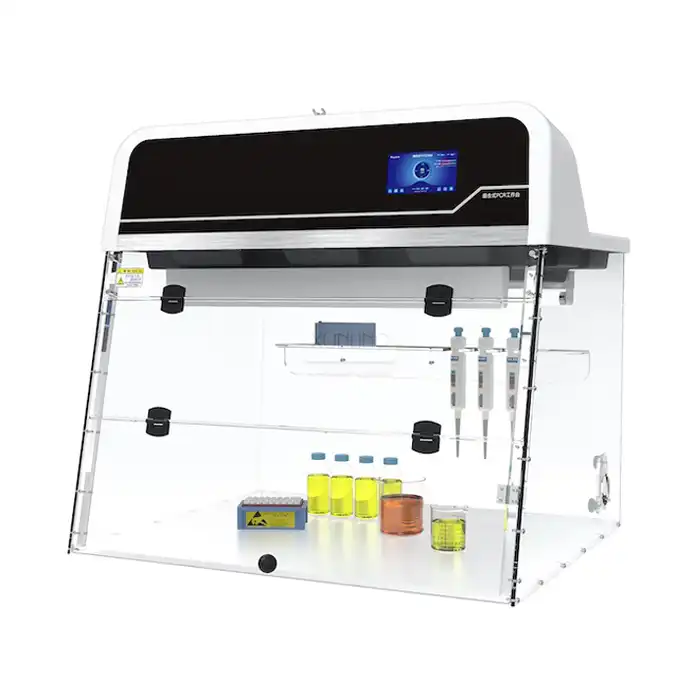
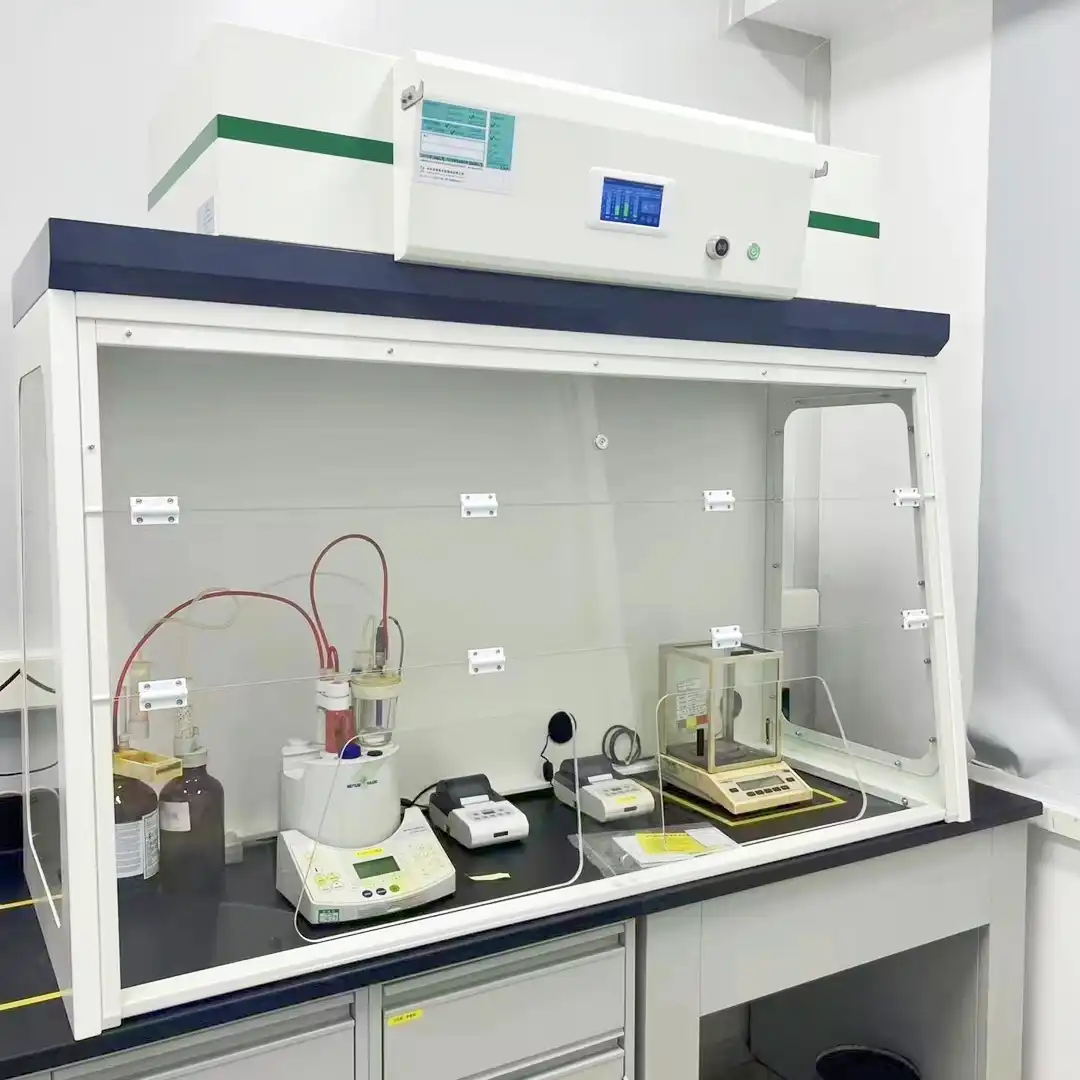
_1741664313364.webp)
_1735472430670.webp)
